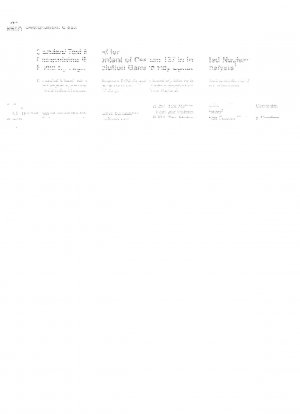ASTM E692-00
Standard Test Method for Determining the Content of Cesium-137 in Irradiated Nuclear Fuels by High-Resolution Gamma-Ray Spectral Analysis
- Standard No.
- ASTM E692-00
- Release Date
- 2000
- Published By
- American Society for Testing and Materials (ASTM)
- Status
- Replace By
- ASTM E692-08
- Latest
- ASTM E692-08
- Scope
This test method uses a high-resolution gamma-ray spectrometer as a basis for measuring the gamma-ray emission rate of 137Cs-137mBa in a dilute nitric acid solution containing 10 mg/L of cesium carrier. No chemical separation of the cesium from the dissolved-fuel solution is required. The principal steps consist of diluting a weighed aliquot of the dissolved-fuel solution with a known mass of 1 M nitric acid (HNO3) and measuring the 662 keV gamma-ray count rate from the sample, then measuring the 662 keV gamma-ray count rate from a standard source that has the same physical form and counting geometry as the sample.
The amount of fuel sample required for the analysis is small. For a sample containing 1 mg of fuel irradiated to one atom percent fission, a net count rate of approximately 103 counts per second will be observed for a counting geometry that yields a full-energy peak efficiency fraction of 1 × 10-3. The advantage of this small amount of sample is that the concentration of fuel material can be kept at levels well below 1 g/L, which results in negligible self-absorption in the sample aliquot and a small radiation hazard to the analyst.
1.1 This test method covers the determination of the number of atoms of Cs in aqueous solutions of irradiated uranium and plutonium nuclear fuel. To minimize interference from short-lived fission products, the fuel should decay 4 months or more prior to the gamma-ray emission-rate measurement.
1.2 When combined with a method for determining the initial number of fissile atoms in the fuel, the results of this analysis allows atom percent fission (burnup) to be calculated. The determination of atom percent fission, uranium and plutonium concentrations, and isotopic abundances are covered in Test Methods
E267 and E321.1.3 Cs is not suitable as a fission monitor for samples that may have lost cesium during reactor operation. For example, a large temperature gradient enhances Cs migration from the fuel region to cooler regions such as the radial fuel-clad gap, or to a lesser extent, towards the axial fuel end.
1.4 The Cs distribution may be ascertained by an axial gamma-ray scan of the fuel element to be assayed. In a mixed-oxide fuel, comparison of the Cs distribution with the distribution of nonmigrating fission-product nuclides such as Zr or Ce would indicate the relative degree of Cs migration. A nonuniform Cs distribution should alert the analyst to the potential loss of the fission nuclide.
1.5 This standard may involve hazardous materials, operations, and equipment. This standard does not purport to address all of the safety problems associated with its use. It is the responsibility of whoever uses this standard to consult and establish appropriate safety and health practices and determine the applicability of regulatory limitations prior to use.
ASTM E692-00 Referenced Document
- ASTM E170 Standard Terminology Relating to Radiation Measurements and Dosimetry
- ASTM E181 Standard Test Methods for Detector Calibration and Analysis of Radionuclides
- ASTM E219 Test Method for Atom Percent Fission in Uranium Fuel (Radiochemical Method) (Withdrawn 2001)
- ASTM E267 Standard Test Method for Uranium and Plutonium Concentrations and Isotopic Abundances
- ASTM E321 Standard Test Method for Atom Percent Fission in Uranium and Plutonium Fuel (Neodymium-148 Method)
ASTM E692-00 history
- 2008 ASTM E692-08 Standard Test Method for Determining the Content of Cesium-137 in Irradiated Nuclear Fuels by High-Resolution Gamma-Ray Spectral Analysis
- 2000 ASTM E692-00 Standard Test Method for Determining the Content of Cesium-137 in Irradiated Nuclear Fuels by High-Resolution Gamma-Ray Spectral Analysis
